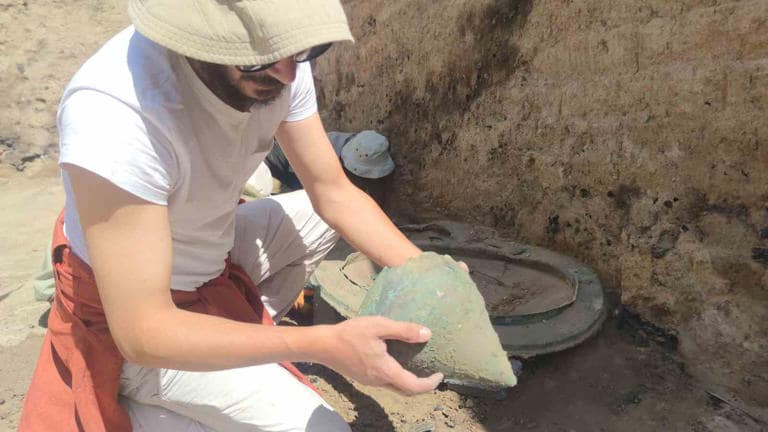
Three 2700-year-old bronze shields and a bronze helmet dedicated to the Urartian “god” Haldi found in Ayanis castle
Three bronze shields and a bronze helmet dedicated to the Urartian “god” Haldi were found in the fortress of Ayanis in the eastern Anatolian province of Van.
The Urartian civilization was established in the region that today borders Türkiye, Iran and Armenia, especially in Eastern Anatolia, from the 9th century BC.
This state, whose capital was Tuspa (today’s Van), dominated vast territories during its most powerful period and became an important center of civilization.

Ayanis Castle is located on a rocky hill near the village of Ağartı, formerly known as “Ayanis”, on the eastern shore of Lake Van, 38 km east of the capital city of Tuspa.
The fortress was built by Rusa II, son of Argishti, who ruled the Urartian Kingdom between 685 BC and 653/650 BC.

Ayanis Castle is of great importance in terms of illuminating the last stages of Urartian history.

Archaeological excavations at Ayanis Castle have been going on for 36 years. Since the last 10 years, it has been carried out under the chairmanship of Prof. Dr. Mehmet Işıklı, a faculty member of Atatürk University Faculty of Letters, Department of Archaeology.

Prof. Dr. Mehmet Işıklı said in his statement, ‘During this year’s excavations, we unearthed 3 bronze shields and 1 helmet in very good condition. The shields and helmet are dedicated to Haldi, the chief god and god of war. As you know, Ayanis Castle suffered a great earthquake. Due to this earthquake, there was a major collapse caused by the mudbrick walls. Therefore, many artifacts were deformed. However, the artifacts found are in very good condition as they were found at a depth of about 6-7 meters on the floor of the room.”

“The helmet is decorated and we guess that it was a ceremonial helmet. Because we can catch some of the decorations now, of course, these decorations and ornaments will be beautiful after a comprehensive restoration and conservation. All of these are actually very strong evidence that a royal, a religious elite group used that area. As a result of 36 years of excavations, Ayanis Castle have presented a very rich repertoire of bronze artifacts, especially bronze weapons.”
Cover Photo: IHA
You may also like
- A 1700-year-old statue of Pan unearthed during the excavations at Polyeuktos in İstanbul
- The granary was found in the ancient city of Sebaste, founded by the first Roman emperor Augustus
- Donalar Kale Kapı Rock Tomb or Donalar Rock Tomb
- Theater emerges as works continue in ancient city of Perinthos
- Urartian King Argishti’s bronze shield revealed the name of an unknown country
- The religious center of Lycia, the ancient city of Letoon
- Who were the Luwians?
- A new study brings a fresh perspective on the Anatolian origin of the Indo-European languages
- Perhaps the oldest thermal treatment center in the world, which has been in continuous use for 2000 years -Basilica Therma Roman Bath or King’s Daughter-
- The largest synagogue of the ancient world, located in the ancient city of Sardis, is being restored











Leave a Reply